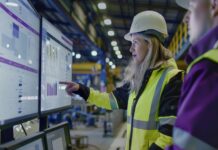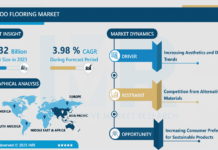Investment when it comes to smart building technologies has gone on to have a massive impact on facility management, thereby making it one of the most influential trends in technology. The market, which already happens to be worth billions of dollars, is likely to experience rapid growth. It has in it a wide range of technologies, which include optimized climate control, smart parking garages, as well as self-cleaning bathrooms. Additionally, there happen to be umpteen known use cases and also potential applications that have not been explored yet.
It is well to be noted that smart building refers to a building or structure that makes use of automated processes so as to efficiently handle as well as regulate its operations, which include HVAC, lighting, security, as well as various other systems. It goes on to achieve this by way of a comprehensive network of sensors, actuators, and microchips that consistently generate raw data that can be transformed into insights that are extremely valuable. These insights are used to drive continuous improvements such as cost reduction as well as increased overall efficiency. A platform like service automation truly makes sure to demonstrate its value by changing complex data into actionable information that is tailor-made for facility managers.
It is indeed imperative to differentiate between individual smart building technologies, as they often overlap or even interact with each other, and apparently each technology goes on to provide a unique layer of functionality. Let us look at 7 highly influential smart building technologies that are currently available:
- Internet of Things
It is a well-known fact that smart buildings are characterized by their use of IoT systems. These systems go on to connect numerous devices by way of a shared Internet Protocol- IP platform, thereby helping the exchange as well as the analysis of information. Because of this, the controls on each device get optimized automatically.
When devices happen to be linked and managed via sensors, microchips, controllers, as well as switches, they are able to communicate as well as partner with each other. There are numerous applications for this technology, which range from automatically regulating temperature to programming emergency systems.
The Internet of Things- IoT has gone on to gain significant prominence, especially when it comes to its application to smart home technology like the development of self-learning thermostats as well as smart utility meters. In recent history, there has been a significant surge in the number of applications that are being used in commercial as well as industrial settings. These applications serve the idea when it comes to improving internal operations like IoT-enabled asset condition management and also enhancing the complete experience for occupants. Most of the time, IoT-linked devices are controlled as well as connected by way of the Internet using a mobile application. This enables users to have a convenient as well as user-friendly experience when using these devices.
Many executives as well as facilities managers opt to enhance the intelligence of their buildings so as to reduce expenses, conserve energy, and also minimize periods of inactivity. Smart HVAC along with smart lighting systems have the capacity to greatly elevate the experience of both guests as well as employees.
It is well to be noted that one popular as well as powerful application of IoT in commercial facilities is execution when it comes to smart restrooms. Notably, the quality and cleanliness of washrooms often receive the most complaints and can go on to deter customers. Apparently, the IoT sensors have the ability to take care of issues proactively by pinpointing and resolving them before they occur. For instance, smart soap as well as paper towel dispensers can go on to digitally notify cleaning crews when the levels are running low and, at times, even restock themselves as required. Intelligent occupancy trackers precisely determine when a restroom is operating at full capacity. By utilizing a mobile application, visitors can conveniently go on to access information with regards to the approximate wait time when it comes to the restroom. Moreover, this type of sensor is capable of automatically scheduling cleaning crews as soon as a predetermined number of visitors have passed through.
- AI & ML
The application of AI in smart buildings is vast, primarily because AI can be seamlessly integrated with IoT sensors and devices, which go on to comprehensively utilize deep learning to comprehend objects as well as environments in a hierarchical manner. They then make alterations based on learned user preferences or a study pertaining to historical trends.
An AI- and IoT-enabled asset management system can go on to detect abnormalities in asset functioning, like a leaking refrigerator. It does this by way of using knowledge it has gained about the machine’s energy intake or output throughout the normal operation. The AI-enabled service automation software happens to be capable of detecting upcoming maintenance tasks and can go on to review as well as approve work orders sans much human intervention.
- Building Automation
Building automation is all about a comprehensive infrastructure that helps in the centralized control of numerous systems within a building, such as HVAC, lighting, security, etc. Building automation is typically controlled by either a BMS or a Building Automation System- BAS. These systems serve as central digital or mobile hubs for managing and controlling numerous aspects of a building’s automation. These systems happen to be compatible with IoT solutions. They happen to have the capacity to monitor and control crucial factors like temperature, humidity, electricity, water pressure, etc.
It is well to be noted that building automation offers several benefits that range from enhanced energy efficiency to reduced operating expenses to elevated comfort for occupants. The use of smart building technologies helps in elevating the workplace environment, thereby resulting in increased productivity. A building automation system happens to have the capacity to adjust the air conditioning and, at the same time, enhance ventilation in a designated conference room when it detects that the lights have been switched on. It can even work alongside AI as well as IoT technologies.
- Building Information Modeling
Building Information Modeling- BIM enables the recording of facility information such as blueprints, emergency plans, plumbing, and electrical installations. This information can then be modelled within 3D and also stored digitally, thereby offering convenient access to the employees. BIM has mainly been used by professionals in the AEC industry in the past, but it has now gained popularity when it comes to facility management.
BIM happens to be a valuable resource when it comes to facility maintenance as well as ongoing use. It functions as a complete building handbook that goes on to offer real-time asset profiles as well as enhance awareness of asset locations. It can help pinpoint specific electrical circuits or some machinery that is hidden behind the walls. Apart from providing geographic information, it also gives valuable insights into spatial awareness.
- Augmented Reality
AR happens to be a technology that offers a real-time, enhanced view when it comes to the physical world by overlaying computer-generated sensory input into it. It typically involves the use of a camera as well as a viewing device such as a tablet, smartphone, or even eyeglasses. It enables for the superimposition when it comes to virtual objects onto a person’s real, physical surroundings. The maintenance crew will then have access to on-site information via BIM. Additionally, they will also be able to view the information directly in front of them by way of using their phone camera.
- Virtual Reality
The design as well as construction industries have already gone on to embrace VR as a valuable tool during the mockup phase. VR-powered mockups happen to offer clients the opportunity to feel a proposed building by engaging themselves in a virtual environment that goes on to simulate the actual space. The client gets the benefit of exploring the surroundings, inspecting the windows as well as staircases, and also gaining a sense of the entire experience and layout of the finished structure, all before the commencement of any construction.
While virtual reality is not widely used yet in the facilities management industry, it has become more powerful as well as affordable in the recent past. VR equipment helps with various applications such as dynamic quality checks, 3D internal design reviews, and virtual walkthroughs.
- Aerial Drones
It is no surprise that drones have proven to be valuable beyond their traditional utilization of aerial photography as well as package delivery. They can be efficiently made use of within buildings or retail spaces so as to provide intelligent support, taking on numerous routine or time-consuming tasks. This enables employees to allocate their time as well as energy towards more significant responsibilities. These unmanned aerial vehicles can be made operational remotely and may also use AI to operate autonomously.




























